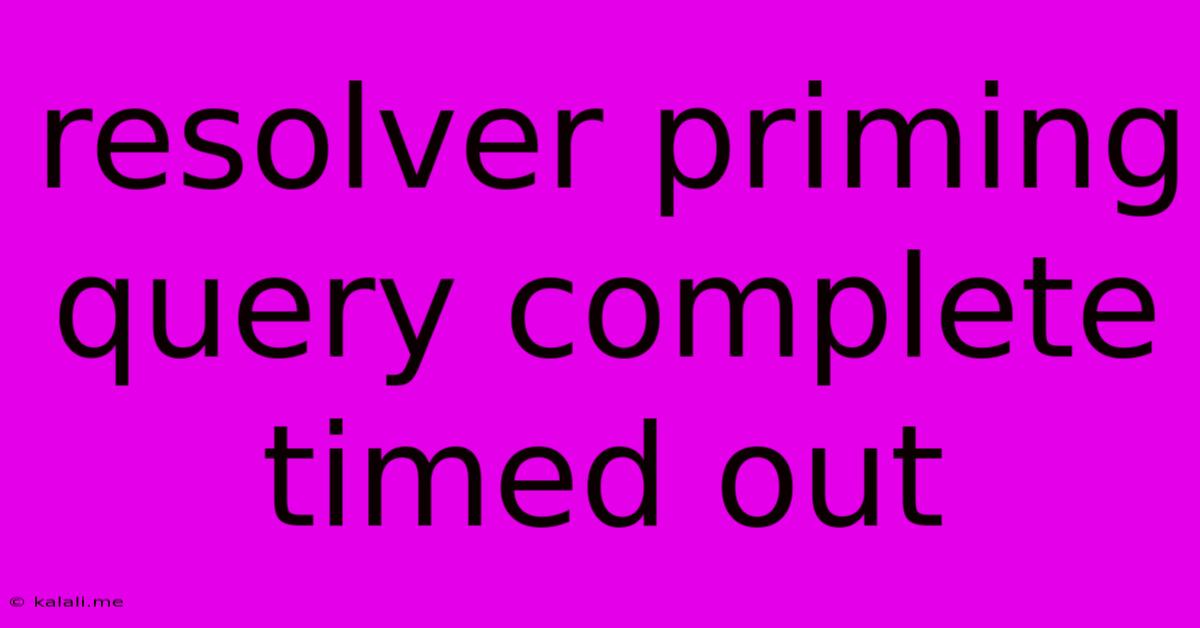Resolver Priming Query Complete Timed Out
Kalali
Jun 09, 2025 · 3 min read

Table of Contents
Resolver Priming Query Complete Timed Out: Troubleshooting DNS Resolution Issues
The error message "resolver priming query complete timed out" indicates a problem with your system's ability to resolve domain names to IP addresses. This typically stems from issues with your Domain Name System (DNS) configuration or network connectivity. This article will guide you through understanding the error and implementing effective troubleshooting steps. This error can be frustrating, but with a systematic approach, you can usually resolve it quickly.
Understanding the Error
Before diving into solutions, let's understand what the error means. When your device tries to access a website or online service, it first needs to translate the domain name (e.g., www.example.com) into an IP address (e.g., 192.0.0.1). This translation is handled by DNS servers. "Resolver priming" refers to the initial process of contacting DNS servers to establish a connection and retrieve necessary information. A "timed out" error signifies that this initial connection attempt failed within the allocated time limit. This means your device couldn't contact the DNS server within a reasonable timeframe. Several factors could contribute to this problem.
Common Causes and Troubleshooting Steps
Here's a breakdown of the most common causes and how to troubleshoot them:
1. Network Connectivity Problems:
- Check your internet connection: Ensure your device is properly connected to the internet. Try accessing other websites to confirm connectivity. A simple power cycle of your modem and router can often resolve temporary connection glitches.
- Check for network outages: Inquire with your internet service provider (ISP) to rule out any planned or unplanned outages in your area.
- Test your network cable: If you're using a wired connection, check for damaged or loose cables.
2. DNS Server Issues:
- Incorrect DNS server settings: Your device might be configured to use incorrect or unavailable DNS server addresses. Try changing your DNS settings to a known reliable public DNS server like Google Public DNS (8.8.8.8 and 8.8.4.4) or Cloudflare DNS (1.1.1.1 and 1.0.0.1). Instructions for changing DNS settings vary depending on your operating system.
- DNS server overload or malfunction: The DNS server you're using might be experiencing high traffic or a temporary outage. Switching to a different DNS server, as mentioned above, is a good workaround.
- Firewall or antivirus interference: Your firewall or antivirus software might be blocking access to DNS servers. Temporarily disabling these (only for troubleshooting purposes!) can help determine if this is the culprit. Remember to re-enable them afterward.
3. Host File Issues (Less Common):
- Corrupted hosts file: The hosts file on your system maps domain names to IP addresses. A corrupted hosts file can interfere with DNS resolution. You can try resetting or editing this file (exercise caution when editing system files!), but this is usually a less common cause of this specific error.
4. System-Level Problems:
- Operating system issues: In rare cases, underlying operating system problems can impact DNS resolution. Consider restarting your device or performing a system update/repair if other troubleshooting steps fail.
Advanced Troubleshooting:
If the above steps don't resolve the issue, consider these advanced options:
- Check your network adapter settings: Verify that your network adapter is correctly configured and functioning properly.
- Run network diagnostics: Most operating systems provide built-in network diagnostic tools that can help identify and troubleshoot network problems.
- Consult your network administrator: If you're on a corporate or institutional network, contact your network administrator for assistance.
Prevention and Best Practices:
- Regularly update your operating system and network drivers: This helps ensure compatibility and address potential bugs.
- Use a reliable DNS server: Choosing a reputable public DNS server can improve reliability and speed.
- Monitor your network for performance issues: Regular monitoring can help you identify and address problems before they escalate.
By systematically working through these steps, you should be able to pinpoint the cause of the "resolver priming query complete timed out" error and restore your internet connectivity. Remember to always back up your data before making significant system changes. If the problem persists despite these troubleshooting efforts, seeking help from a computer professional might be necessary.
Latest Posts
Latest Posts
-
How Long Can A Peanut Butter And Jelly Sandwich Last
Jun 09, 2025
-
How To Change Stats Rpg Maker Mv
Jun 09, 2025
-
Yellow Robot With Display For Face
Jun 09, 2025
-
Type Emojis In Mac Messenger Just Like Slack
Jun 09, 2025
-
Sausage Party Ending Of The Movie
Jun 09, 2025
Related Post
Thank you for visiting our website which covers about Resolver Priming Query Complete Timed Out . We hope the information provided has been useful to you. Feel free to contact us if you have any questions or need further assistance. See you next time and don't miss to bookmark.